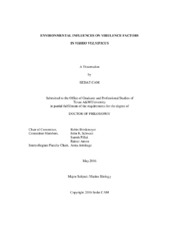| dc.description.abstract | Understanding the environmental factors influencing virulence of V. vulnificus is of utmost importance in reducing human exposure to this deadly pathogen. Quantitative PCR assays for the virulence indicator genes vcg and 16S rRNA type A/B were used to examine fluctuations in virulence with season in Galveston Bay oysters. A strong seasonal shift of V. vulnificus strain types was observed. Environmental strains (16S rRNA type A) predominated from April to mid-June as temperatures rose 20 to 28°C and salinities increased from 22 to 27 PSU. As temperatures increased to ≥30°C from mid-June to September and salinities rose above 27 PSU, clinical strains (16S rRNA type B; vcgC) predominated.
Enrichment media was tested for selective enrichment for environmental or clinical strains from seawater. Ratios of clinical to environmental strains enriched in alkaline peptone water (APW) remained constant, however Brain Heart Infusion Broth (BHIB), with its higher iron content, preferentially enriched for clinical strains indicating that iron plays an important role in the infection of the human host.
Biofilm formation by clinical and environmental reference strains of V. vulnificus were tested under different temperature pH and iron concentration conditions. Clinical strains were found to produce significantly more biofilm than environmental strains at 24°C versus 30°C or 37°C. There was a significant trend for clinical strains of V. vulnificus to form more biofilm at acidic pH (5.5) than environmental strains, at both 24°C and 37°C, indicating that biofilm may be important for survival of clinical strains in the gastrointestinal tract of the human host. There was a strong, direct correlation between iron concentration in the growth medium and biofilm production by all strains tested. With regards to temperature and pH, higher biofilm production appears to be a trait of clinical strains and could be considered a virulence factor.
Examination of genes encoding for virulence factors hemolysin/cytolysin and capsular polysaccharide during biofilm formation revealed that their expression was influenced by maturity of the biofilm as well as by temperature. Both genes were up-regulated during biofilm formation indicating that biofilm may be the preferred form of V. vulnificus in the human host. | en |


